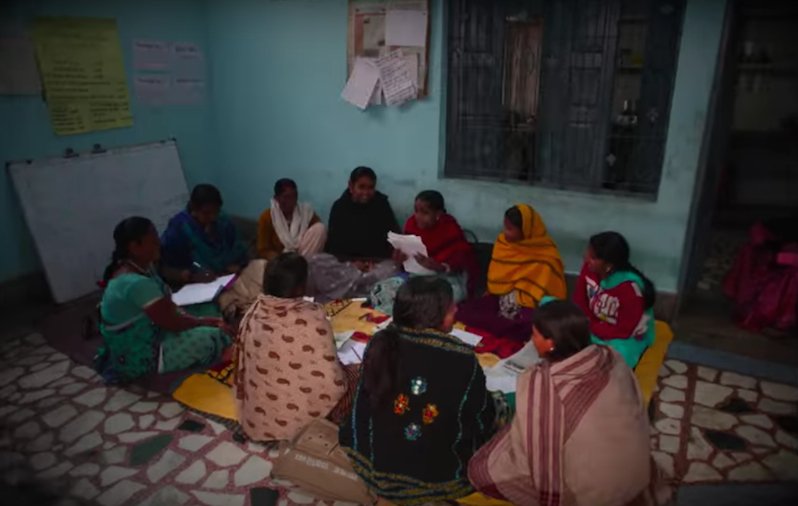Truthdiggers of the Week: The Women at Khabar Lahariya, a Feminist Newspaper in Rural India
Now in its 14th year, the publication just expanded into digital platforms in the hope of increasing readership and inspiring other young women. An editorial meeting at Khabar Lahariya. (Screen shot via YouTube)
An editorial meeting at Khabar Lahariya. (Screen shot via YouTube)
An editorial meeting at Khabar Lahariya. (Screen shot via YouTube)
Every week the Truthdig editorial staff selects a Truthdigger of the Week, a group or person worthy of recognition for speaking truth to power, breaking the story or blowing the whistle. It is not a lifetime achievement award. Rather, we’re looking for newsmakers whose actions in a given week are worth celebrating.
Khabar Lahariya just went digital. The publication, which launched in 2002 under the helm of a women’s education initiative, is run entirely by women from mostly low-caste, marginalized, rural Indian villages. Now, in the publication’s 14th year, Khabar Lahariya is expanding to digital platforms, utilizing applications such as WhatsApp and Facebook to share video content.
The newspaper, whose name means “News Waves” in Bundeli, is partnering with the firm Chambal Media to distribute digital content. “We see a feminist business model as one where profitability can be achieved while holding close to the values of independent, progressive rural news,” says Shalini Joshi, one of the paper’s co-founders. Khabar Lahariya’s chief reporter, Meera, explains how including video reports has increased the paper’s prestige. “[I]t shows people that we are on the ground and reporting facts, that we’re not just making things up.”
Khabar Lahariya’s editorial team is used to attacks on its credibility, as most of the women come from extremely patriarchal communities. “Sometimes, when I’m riding out to work, the men stop me and ask me mockingly: ‘Madam reporter, what is the news of the day?’ ” Shraddha Bhaskar, a reporter for the Awadhi-language edition of the paper, tells The Guardian. Like most of the women involved in the publication, she doesn’t let sexist attitudes bother her. “I tell them they would have known it if they read the paper.”
Joshi adds that she “wanted to bring more women into journalism and establish an independent newspaper. … By independent, I mean not influenced by corporate or political agendas.” Although the paper has traditionally relied on donations from nongovernmental organizations, the women at Khabar Lahariya hope to increase revenue through advertising.
Their commitment to maintaining a feminist publication remains strong. “We try to give women voices, and tell stories from their points of view when possible,” Joshi says. “We have a whole page dedicated to women’s issues in the paper and a women’s column on the website.”
The attitudes of Khabar Lahariya’s staff are indeed reflected in what they choose to report. The publication “describes itself as “a weapon of the weak” and often reports on local women’s issues, particularly violence against women, which is prominent in rural, patriarchal villages.
A recent piece published by Khabar Lahariya is a perfect example of how women are defying gender norms in India while dealing with horrific violence due to sexism at the same time. It tells the story of Rajkumari, a woman whose daughter, Geeta, was gang-raped after Rajkumari won a local election:
Rajkumari says she was threatened by one of her opponents … in the election. He repeatedly told her not to run for elections, if she did, something bad would happen to her. He told her that she wouldn’t be allowed to win. Rajkumari’s father Ramdhani says, “They came again on the day of counting. They said if my daughter won, they’ll do what it takes that she isn’t able to show her face in public.” …
The next day, Rajkumari took Geeta to the police station at Paladi. The police refused to lodge an FIR, or to send her for a medical examination. They didn’t let them leave the station either. According to Rajkumari, the police subjected the 16-year-old to abrasive, insensitive questioning. “What happened, are you suffering from jaundice that you can’t speak a word,” said … the constable at the station. They interrupted Geeta’s testimony multiple times, asking her to describe exactly what the accused did and how. Sniggering behind their questions, they suggested that Geeta should simply agree to a settlement.
Another piece by the newspaper highlights the nonviolent ways female election winners are suppressed in rural communities:
A woman candidate named Munni Devi won the ZP Member elections from Ward 65 in Mahua, but she hasn’t been seen since campaign days. She hasn’t even picked up the certification that officially declares her an elected official. Instead, it’s her husband Gorelal who comes to pick up these papers, and he gets his picture taken with the election officials, who smile for the camera as they hand him the certificate. These vote-counting officials are not interested in pointing out that it’s his wife who has won, not him – they pose very happily for the picture. There’s nothing unusual about this to them.
Gorelal is the one who has been garlanded and congratulated on “winning” the seat. When we try to talk to Munni Devi, she is unavailable; Gorelal speaks in her place and says, “What work do women have here? I’m the one who does everything around here.”
Khabar Lahariya’s Twitter feed is filled with additional examples of its commitment to covering cases of violence against women:
Most registered cases of #violence against #Dalits in Uttar Pradesh. As of 2014 8,075 cases to be exact! pic.twitter.com/hqdNmvlc7T
— Khabar Lahariya (@KhabarLahariya) July 6, 2016
Show some love and solidarity for our firebrand #journalist Shivdevi!#TeamKhabarLahariya #inspiration #fearless pic.twitter.com/tlmSLp2tQV
— Khabar Lahariya (@KhabarLahariya) June 15, 2016
Other women’s topics, such as low literacy rates, are reported as well:
A statistic speaks a 1000 words!#fridayfact #literacy #gendergap #Bundelkhand #KhabarLahariyaReports pic.twitter.com/6ubx7Y34Em
— Khabar Lahariya (@KhabarLahariya) June 17, 2016
The publication also highlights the achievements of fellow Indian women on its digital platforms:
#World watch out! #India is ready with its first female fighter pilots!
Avani Chaturvedi,Bhawana Kanth &Mohana Singh pic.twitter.com/gpSQ6eMxpr— Khabar Lahariya (@KhabarLahariya) June 11, 2016
Dignity of labour. Women hand-pump mechanics!#womenofBundelkhand #WomenOfSteel #KhabarLahariyaReports pic.twitter.com/EKKaoKgjav
— Khabar Lahariya (@KhabarLahariya) June 10, 2016
Gender-based conventions aren’t the only thing the women at Khabar Lahariya are fighting. Many assume that rural parts of India are technologically disadvantaged, when in fact the opposite is true. Vidhi Doshi of The Guardian explains:
Over the past decade, a digital revolution has swept across India, and more than 350 million Indians have access to the internet, most of them on smartphones. In rural India, millions of people still live without electricity, but most households have at least one solar-powered battery charger for their mobile phone. Without television, or easy access to urban centres, smartphones are often the only source of entertainment.
Khabar Lahariya has come a long way since 2002. It began as a fortnightly publication but has evolved into a weekly newsletter published in multiple languages. Ila Ananya spoke with Disha Mullick, a co-founder of Khabar Lahariya, to learn how the expansion into digital platforms has affected the publication’s readership. She writes:
Mullick says that with the internet and social media, most of their audience comes from rural Bundelkhand, where they have 1.5 lakh [a unit in the Indian numbering system equal to 100,000] viewers, from people who are between 18-35 years old. While their audience does have more men than women, the 33 per cent increase in women readers shows that there are more young women with smartphones. How is this different from the reach they got with only print newspapers? Khabar Lahariya works in nine districts of UP and Bihar. Four thousand copies are printed, and when distributed, one paper is estimated to be shared between 16-20 people. The audience here comprises of much older men — the traditional set that has been reading newspapers for many years now.
Over the years, Khabar Lahariya has received numerous awards, including the Chameli Devi Jain Award for an Outstanding Woman Mediaperson and the 2009 UNESCO King Sejong Literacy Prize. It has also received critical acclaim from such Indian publications as The New Indian Express, The Hindu and Hindustan Times.
The awards are well deserved, as the reporters at Khabar Lahariya are often forced to overcome enormous hurdles to get a story. “Many women are intimidated and ridiculed for doing their jobs,” says Joshi. “We have one reporter who was threatened so seriously by a village chief that she wouldn’t leave her house and wouldn’t tell any of us what had happened.” Meera recounts a time she narrowly escaped the house of a man who told her, “You like taking photos? Come, let’s take some photos in my bedroom.” Other examples of the women’s extraordinary reporting efforts are showcased on Khabar Lahariya’s social media platforms:
#Reporter Kavita crosses the Ken river that has reached the danger mark due to rains #Journalism #FEARLESS pic.twitter.com/wFqfKdkKvT
— Khabar Lahariya (@KhabarLahariya) July 9, 2016
Despite the risks, the women at Khabar Lahariya are thrilled with their jobs, and they have high hopes for their digital expansion. “With the growth of internet in rural areas, reaching the least likely consumer, for example, the young rural girl, is a massive and exciting opportunity,” says Kavita, another co-founder of Khabar Lahariya. “I think it will bring hundreds of women into journalism from the villages and kasbahs of the country, as producers and consumers, but also as shareholders in a business that could take the media world by storm.”
For their commitment to independent and honest journalism and their efforts to lift up fellow rural women in a male-dominated society, the women behind Khabar Lahariya are our Truthdiggers of the Week.
Your support matters…Independent journalism is under threat and overshadowed by heavily funded mainstream media.
You can help level the playing field. Become a member.
Your tax-deductible contribution keeps us digging beneath the headlines to give you thought-provoking, investigative reporting and analysis that unearths what's really happening- without compromise.
Give today to support our courageous, independent journalists.





